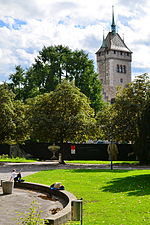Campus Biotech
Biotechnology in SwitzerlandBuildings and structures in GenevaEngineering research institutesLaboratories in SwitzerlandMultidisciplinary research institutes ... and 2 more
Research institutes in SwitzerlandUse British English from March 2014

The Campus Biotech is a Swiss institution hosting research institutes and biotechnology companies. The Campus Biotech is located in the former Merck Serono building, in Geneva (Switzerland).The Campus Biotech is a part of the Swiss Innovation Park.
Excerpt from the Wikipedia article Campus Biotech (License: CC BY-SA 3.0, Authors, Images).Campus Biotech
Neumühlequai, Zurich Unterstrass
Geographical coordinates (GPS) Address Nearby Places Show on map
Geographical coordinates (GPS)
| Latitude | Longitude |
|---|---|
| N 47.3805585 ° | E 8.5405656 ° |
Address
Neumühlequai
8092 Zurich, Unterstrass
Zurich, Switzerland
Open on Google Maps








